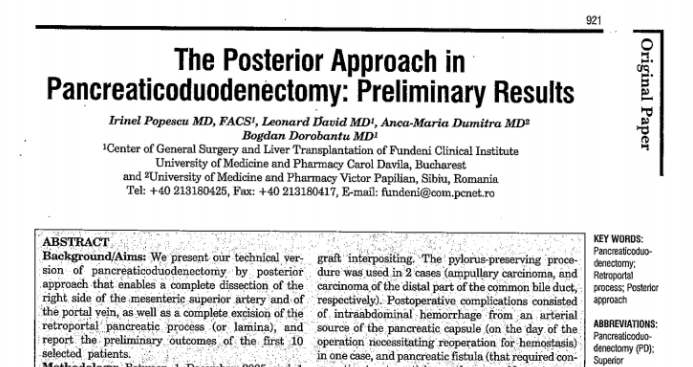The posterior approach in Pancreaticoduodenectomy: Preliminary Results
Irinel Popescu, Leonard David, Anca-Maria Dumitra, Bogdan Dorobantu.
Abstract
BACKGROUND/AIMS:
We present our technical version of pancreaticoduodenectomy by posterior approach that enables a complete dissection of the right side of the mesenteric superior artery and of the portal vein, as well as a complete excision of the retroportal pancreatic process (or lamina), and report the preliminary outcomes of the first 10 selected patients.
METHODOLOGY:
Between 1 December 2005 and 1 March 2006 10 patients (7 males and 3 females) with a mean age of 60.6 years (range 45-81 years) were operated on using this technique. The patients were diagnosed with carcinoma of the pancreatic head (8 cases), ampullary carcinoma (1 case), and carcinoma of the distal part of the common bile duct (1 case). Invasion of the portal vein occurred in 2 of the 8 cases of carcinoma of the pancreatic head.
RESULTS:
No significant intraoperative incident was recorded. The mean operative time was 225 minutes (ranging between 180 and 240 minutes) and the mean blood loss was 372,25cc (range 150-800cc). Two cases of carcinoma of the pancreatic head that had a segmental resection of the portal vein needed vascular reconstruction which was performed by Goretex graft interpositing. The pylorus-preserving procedure was used in 2 cases (ampullary carcinoma, and carcinoma of the distal part of the common bile duct, respectively). Postoperative complications consisted of intraabdominal hemorrhage from an arterial source of the pancreatic capsule (on the day of the operation necessitating reoperation for hemostasis) in one case, and pancreatic fistula (that required conservative treatment) in another case. No postoperative diarrhea, delayed gastric emptying episodes or postoperative deaths were recorded. There were no postoperative deaths. The mean length of hospitalization was 12.2 days (range 10-24 days).
CONCLUSIONS:
The posterior approach in pancreaticoduodenectomy offers an early selection of patients during the operation (in terms of resectability). As compared to the standard procedure, it enables an adequate lymphadenectomy that can be safely performed (by early dissection and isolation of the superior mesenteric artery), and avoids possible intraoperative accidents secondary to anatomical arterial abnormalities. This approach is particularly recommended in cases with portal vein invasion because it allows a „no-touch” resection.
